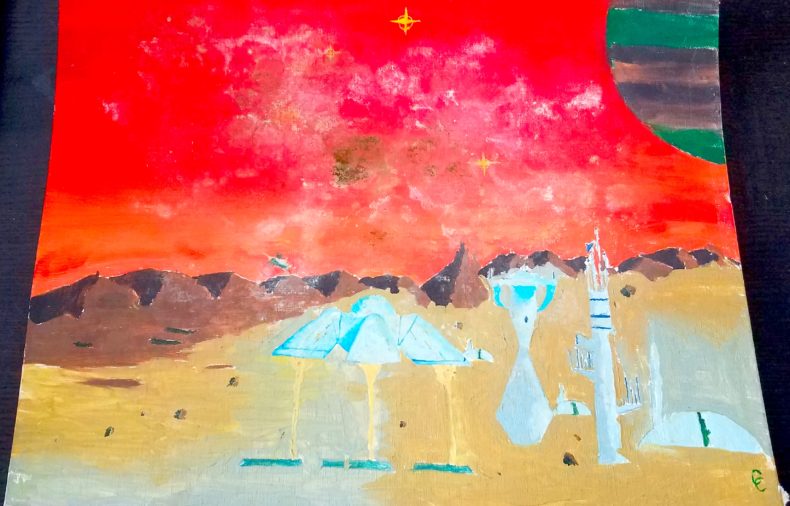
I found this ill-cared-for painting from 1976, when I was nine, of a spaceship either taking off or landing on a barren world.
This was before Star Wars, but I was well-steeped in forbidden worlds and Star Trek. I dreamed of alien planets, their skies red or green, their landscapes sere and wind-torn. I stared for long hours into books with artist representations of unknown moons or galaxies setting on the horizon. How could you not resist the night sky and what could be?
In 1976, my single mother, an artist who worked as a secretary on the side, took a summer with me to live in a cabin in eastern Arizona. She put up her easel in tall-grass fields and painted green mountains and aging barns, wood graying and peeling apart, as I sat on the ground dabbing brushes in oil paints, rendering other worlds on canvases she gave me. You’d think there’d be enough here on Earth for a budding naturalist who gathered rocks, pinecones, and bones all summer, but when I painted, my eyes turned upward, above the whispering canopies of ponderosa pines, over the rolling mountains.
Once you get a notion of what might be out there, your mind never lets go. Our galaxy has 250 billion stars, plus or minus 150 billion, and a hypothesized 40 billion Earth-sized planets within habitable orbits around their suns, making the possibilities seem endless.
At the start of 2020, 4,108 exoplanets have been confirmed. A couple dozen have been identified as Earth-like in size and distance from their suns, and the rest run the gamut. A hot giant Jupiter was logged last year orbiting Proxima Centauri 4.243 light years away, making it our closest known planet and bigger than anything in our solar system. Last week, a second planet around Proxima Centauri was tentatively announced, another massive one, perhaps larger than the first. Imagine these boiling giants, atmospheres glowing. Put yourself in the pull of their gravities.
The discovery of planet K2-18 b orbiting a red dwarf led to evidence last fall of clouds and water vapor in the atmosphere. This is an Earth analog in the constellation Leo, eight times our size, known as a ‘super Earth,’ and it receives about as much radiation as we get from our sun. It is the least massive planet to show signs of clouds where, 124 light years away, it appears to be raining.
You see why a kid might be on hands and knees in a field, dusty and unshowered, living in a cabin, painting other worlds under a bluebird sky. We know the sky isn’t a ceiling. Worlds don’t end with this one.
Painting by CC
Wow! You took us to a wonderful place of memory! My place was on a hill in Durango at my grandmother’s, and a road trip in the old ’52 Chevy to Shiprock. It wasn’t my first painting, but it was my first of something real I had seen with my own eyes. Thank you for reminding me!
The 40 billion earth-sized planets and the infinitesimal galaxies that continue to appear at the outer limits of the universe have convinced me that belief in a personal God is folly. This is probably not the response you would expect, but that’s where my thoughts lie. That God would help a football team win or prevent an accident or any other unplanned event to me is preposterous. For us to think that this minute planet earth among potentially 40 billion is special strikes me as ludicrous. Your writing is inspiring. Your mother gave me your book, “Virga & Bone” and, having read the above, am motivated to read it soon. Your mother and Dick are our new neighbors.
Looks like comb ridge in the background!